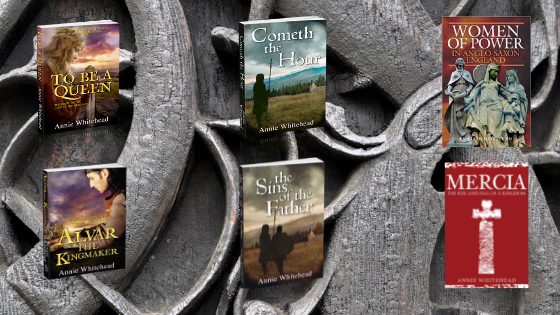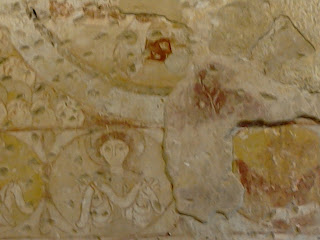To see where they all went, click on the LINK
But now, it's my turn!
~~~~~~~~~~~~~~~~~~~~~~~~
I've only got 24 hours, so I'll make the most of it. I might as well go where I have to be up at dawn, so let's head for my favourite period, Anglo-Saxon England. But let's make it the later part of that period, and I'd like to pick a section where the country isn't being ravaged by Danes. So I'll go for the mid-tenth century, and I'll pop to the court of King Edgar.
I'd love to find out the truth about his women and wives - some think he had three wives, some think only two, but some suggest he carried away a nun and impregnated her. His brother was no better, being, according to many of the chroniclers, caught on his wedding night in bed with his wife, and her mother.
Still, much as I'd love to know the truth, I'm not hanging around for long. The food is not great, and unless I manage to find a seat at a nobleman's table, the bread will be so coarsely-ground that I'll lose my tooth enamel if I eat too much of it. Plus there's likely to be ergot* and other nasties lurking on the plates, so let's skedaddle to my next favourite era...
So, it's lunchtime now, and I reckon there'll be a feast in the court of King Charles II. While I'm enjoying the earliest form of Ice Cream, I'm going to take a good look at the king. His portraits don't suggest that he was especially good-looking, yet he had plenty of mistresses. Surely they can't all have been swayed by the power and wealth alone? Did he have some allure that simply isn't in the paintings?
Only trouble is I won't be able to get that close to him, as only his family, other royals and high-ranking officials were allowed to sit near him, apparently.
And, much as I'd love to stay, Charles enjoyed tucking into pineapple, and I hate the stuff, so I'd best move on.
But, I'm not going far, timewise, maybe just slipping into the early eighteenth century, because I fancy some Baroque dancing I'd like a stately Sarabande. (Remember, this is fantasy, so I'll already have mastered the steps😉)
Baroque Dance - Sarabande à deux (Youtube)So, it's late in the day now, and I'm just going to swap gender, if it's okay. I'd like to be a monk, and sing in a medieval cathedral. Singing is a passion of mine, and those cavernous buildings have wonderful acoustics.
Perhaps something like this: Testamentum Eternum (Youtube)Now that it's dark, and I've managed to avoid doing any work all day, I'm heading back to where I started, to an Anglo-Saxon hall.
The food, as I've already mentioned, will not be especially appetising. Depending on the time of year, one might expect meat - beef, mutton, goose or pork in winter, and lamb or kid in spring and summer - and perhaps fresh fish if the settlement is close to a river or the sea. Fresh cheese would be served in spring and summer, and hard cheese available all year round. Fruits, nuts, and dried vegetables might also be on offer.
There'll be plenty of drink, of course: wine, mead and beer (probably in that order of desirability**)
Here, I'll find plenty of camaraderie, boasting, gaming, and maybe, if we're lucky, the scop will tale a tale like that of Beowulf.
Short extract from Beowulf (Youtube)There might be a riddle or two to solve, and it might be x-rated:
A curiosity hangs by the thigh of a man, under its master's cloak. It is pierced through in the front; it is stiff and hard and it has a good standing-place. When the man pulls up his own robe above his knee, he means to poke with the head of his hanging thing that familiar hole of matching length which he has often filled before.Answer? A key!
I'll settle in for the evening, enjoying the feeling of being part of a close-knit community. I promise I'll come home before daybreak...
~~~~~~~~~~~~~~~~~~~~~~
In all of my novels, there are scenes set in the mead hall, where feasting, drinking and boasting take place. It was an intrinsic part of life in Anglo-Saxon times. Indeed, to be cast out from the hall was to be cast out of society. You can find my books on AMAZON
FEEDAREAD and all other worldwide retailers.
Find me on my website at http://anniewhiteheadauthor.co.uk/
*ergot - fungus that grows on cereal crops
** Food and Drink in Anglo-Saxon England - Debby Banham
** Food and Drink in Anglo-Saxon England - Debby Banham






















